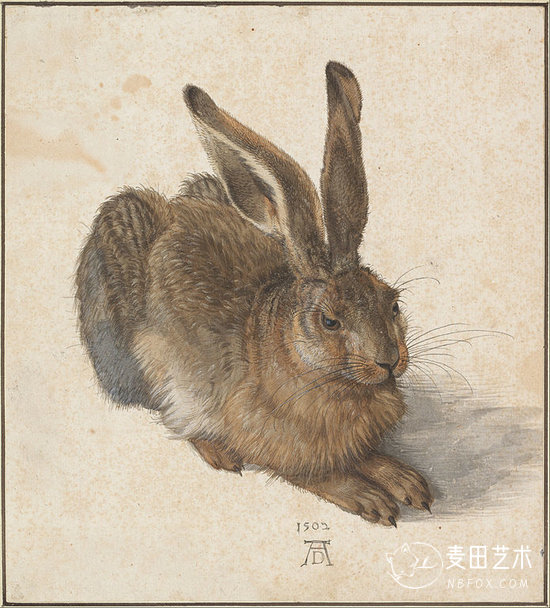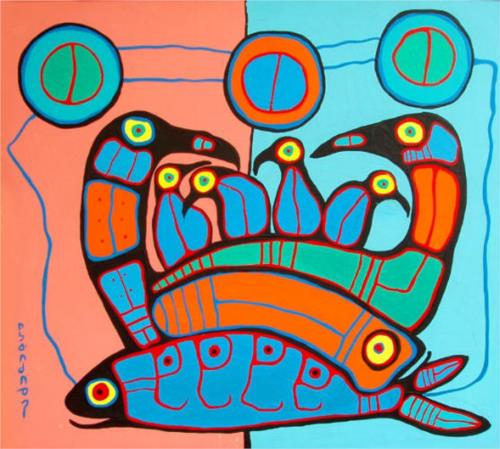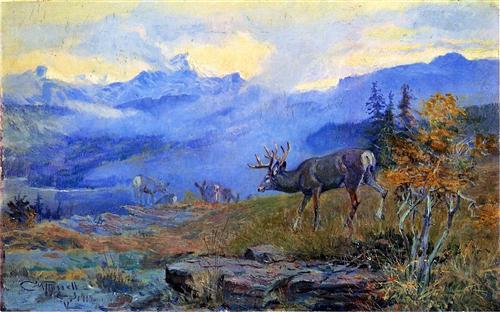图片尺寸:3731 × 4123 像素
作品名称:Young Hare
中文名称:小野兔
创作者:丢勒 Albrecht Durer
创作年代:1502
风格:北方文艺复兴
体裁:动物画
材质:水彩画,paper
现位于:Albertina, Vienna, Austria
实际尺寸:25.1 x 22.6 cm
版权信息: Public Domain(公有领域)
无水印高清图下载
图片尺寸:3731 × 4123 像素
图片大小:3.55 MB
图片格式:JPG
下载方式:百度网盘
下载地址:

作品介绍
机器翻译:
《小野兔》(德语:Feldhase)是德国艺术家阿尔布雷希特-丢勒1502年的一幅水彩和体彩画。这幅画是1502年在他的工作室里画的,被认为是观察艺术的杰作,与次年的《大草坪》并列。这幅作品的主题几乎是以照片的形式呈现的,尽管这幅作品通常被冠以 "年轻的野兔 "的称号,但画像的细节足以让人将野兔识别为成熟的标本--德语标题被翻译为 "田野野兔",这幅作品在英语中通常被称为 "野兔"。
这个主题特别具有挑战性:野兔的皮毛分布在不同的方向,而且动物全身都有浅色和深色的斑点,丢勒不得不适应标准的阴影惯例,通过光线落在人物身上来显示主题的轮廓。尽管在对多色多纹理的主体进行光线渲染方面存在技术挑战,但丢勒不仅成功地创造了一个详细的、几乎是科学的动物研究,而且还为画面注入了温暖的金色光线,从左边照射到野兔身上,突出了耳朵和沿身体的毛发,给眼睛带来了生命的火花,并在右边投下了一个奇怪的阴影。
丢勒轻描淡写地勾勒出图像,并用一些褐色水彩的水洗进行了底涂。然后,他用水彩和体彩的各种深浅笔触耐心地建立起毛皮的纹理。渐渐地,这幅画完成了,增加了一些精致的细节,如胡须和生物眼睛里的窗户的细致反射。
关于丢勒是如何准确捕捉野兔形象的,有一些争论:他可能是在野外画了一只野兔,然后从一只死去的动物身上填入各个细节,或者是捕捉了一只野兔,在画室里把它活生生地抱住,然后进行绘画。窗框在野兔眼睛里的倒影经常被作为丢勒在工作室里从生活中复制野兔的理论的证据,但这种交叉的倒影是丢勒经常使用的一种技术,以增加其对象的眼睛的活力。
丢勒将他的水彩和体彩研究作为版画的素材,但在《有三只野兔的神圣家族》中,野兔的形象并不突出,而在他其他版画中唯一以野兔为主题的作品,即1504年的铜版画《亚当和夏娃》中,野兔正转身离开,半掩在夏娃的腿后。小野兔上突出的日期和丢勒的字母表明,丢勒认为它本身就是一件作品,而不仅仅是一幅准备性的草图。这幅画产生了许多副本:已知至少有12幅来自同时代的作品。
原文:
Young Hare (German: Feldhase) is a 1502 watercolour and bodycolour painting by German artist Albrecht Dürer. Painted in 1502 in his workshop, it is acknowledged as a masterpiece of observational art alongside his Great Piece of Turf from the following year. The subject is rendered with almost photographic accuracy, and although the piece is normally given the title Young Hare, the portrait is sufficiently detailed for the hare to be identified as a mature specimen — the German title translates as "Field Hare" and the work is often referred to in English as the Hare or Wild Hare.
The subject was particularly challenging: the hare's fur lay in different directions and the animal was mottled with lighter and darker patches all over, Dürer had to adapt the standard conventions of shading to indicate the outline of the subject by the fall of light across the figure. Despite the technical challenges presented in rendering the appearance of light with a multi-coloured, multi-textured subject, Dürer not only managed to create a detailed, almost scientific, study of the animal but also infuses the picture with a warm golden light that hits the hare from the left, highlighting the ears and the run of hair along the body, giving a spark of life to the eye, and casting a strange shadow to the right.
Dürer lightly sketched the image and underpainted it with some washes of brown watercolour. Then he patiently built up the texture of the fur with a variety of dark and light brushstrokes in both watercolour and bodycolour. Gradually, the painting was brought to completion with the addition of a few refined details such as the whiskers and the meticulous reflection of a window in the creature's eye.
There is some debate over how Dürer accurately captured the image of the hare: he may have sketched a hare in the wild and filled in the individual details from a dead animal, or captured one and held it alive in his studio while he worked on the painting. A reflection of the window frame in the hare's eye is often cited as evidence for the theory that Dürer copied the hare from life in his workshop, but this cross-barred reflection is a technique that Dürer frequently used to add vitality to the eyes of his subjects.
Dürer used his watercolour and bodycolour studies as source material for his prints, but in The Holy Family with Three Hares the hares are modestly rendered, and in the only of his other prints to feature a hare, the 1504 copperplate engraving Adam and Eve, the hare is turning away, half-hidden behind the legs of Eve. The prominent date and Dürer monogram on the Young Hare indicate that Dürer considered it a work in its own right rather than merely a preparatory sketch. The painting engendered numerous copies: at least twelve from contemporaries are known.





